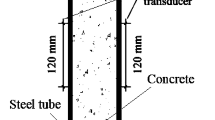The influence of the deflocculant of the Russian company Polyplast-UralSib LLC on the properties of trough and self-flowing masses for lining the working surfaces of thermal units is considered. It is established that introduction of a deflocculant in an amount of 2.0 wt.% into refractory concrete masses ensures satisfactory workability of the mass and the required physical and mechanical properties of concrete after firing at 1000 and 1400°C, compared to the introduction of imported deflocculants ADW/ADS and SioxX/Siox-Quick. It is shown that the trough concrete obtained using the Russian deflocculant has higher strength than concrete with an imported deflocculant, including 0.5 wt.% ADW1 and 0.5 wt.% ADS3. Petrographic analysis revealed equal resistance of the trough concrete to the effects of blast furnace slag whether the Russian additive and or the imported SioxX and Siox-Quick additives were used as deflocculants in the amount of 2.0 and 0.5 wt.%, respectively.

Similar content being viewed by others
References
W. E. Lee, W. Vieira, S. Zhang, et al., “Castable refractory concretes”, Int. Mater. Rev., 46(3), 145 – 167 (2001).
M. R. Ismael, R. Salomão, and V. C. Pandolfelli, “Colloidal silica as a nanostructured binder for refractory castables”, Refractories Applications and News, 11(4), 16 – 20 (2006).
M. R. Ismael, R. Salomão, and V. C. Pandolfelli, “Refractory castables based on colloidal silica and hydratable alumina”, Am. Ceram. Soc. Bull., 86(9), 58 – 62 (2007).
X. Ji Quan, P. Yun Tao, X. Da Yong, and M. Xue Song, “The characteristics of silica-sol combining refractories”, Adv. Mater. Res., 396 – 398, 288 – 291 (2012).
M. Nouri-Khezrabad, M. A. L. Braulio, V. C. Pandolfelli, and F. Golestani-Fard, “Nano-bonded refractory castables”, Ceram. Int., 39, 3479 – 3497 (2013).
R. Sarkar, A. Kumar, S. P. Das, and B. Prasad, “Silica sol bonded high alumina castable: effect of reduced sol”, Refractories Worldforum, No. 2, 83 – 87 (2015).
I. D. Kashcheev, M. G. Ladygichev, and V. L. Gusovsky, Unformed Refractories [in Russian], reference in 2 volumes; 2nd ed., editor I. D. Kashcheev, Teplotekhnik, Moscow (2004) 400 p.
M. Nouri-Khezrabad, V. R. Salvini, A. P. Luz, et al., “Rheological performance of high alumina nano-bonded refractory castables containing carboxylic acids as additives”, Ceram. Int., 41, 11251 – 11256 (2015).
A. R. Studart, V. C. Pandolfelli, E. Tervoort, and L. J. Gauckler, “Selection of dispersants for high-alumina zero-cement refractory castables”, J. Eur. Ceram. Soc., 23, 997 – 1004 (2003).
H. Justenes, “Acceleration by retardation in hydration process for cement-based materials”, Journal of the Chinese Ceramic Society, 38, 1618 – 1622 (2010).
Y. Wang, B. Zhu, X. Li, and P. Chen, “Effect of dispersants on the hydrate morphologies of spinel-containing calcium aluminate cement and on the properties of refractory castables”, Ceram. Int., 42(1), part A, 711 – 720 (2016).
C. Wohrmeyer, J.-M. Auvray, and C. Zetterstorm, “Dry out of dence refractory castables via use of permeability enhancing active compound”, 59thInternational Colloquium on Refractories, Aachen (2016) p. 40 – 44.
A. P. Luz, M. H. Moreira, C. Wöhrmeyer, et al., “Drying behavior optimization of dense refractory castables by adding a permeability enhancing active compound”, Ceram. Int., 45(7), part A, 9048 – 9060 (2019).
B. P. Bezerra, A. P. Luz, and V. C. Pandolfelli, “Novel drying additives and their evaluation for self-flowing refractory castables”, Ceram. Int., in print (2019) DOI: https://doi.org/10.1016/j.ceramint.2019.10.025.
S. S. Kaprielov, V. I. Travush, N. I. Karpenko, and A. V. Sheinfeld, “Modified high-strength concrete of classes B80 and B90 in monolithic structures” [in Russian], Stroitel’nye Materialy, No. 3, 9 – 13 (2008).
S. S. Kaprielov, A. V. Sheinfeld, and G. S. Kardumyan, New Modified Concrete [in Russian], Printing house “Paradiz”, Moscow (2010) 258 p.
A. V. Sheinfeld, “Organo-mineral modifiers as a factor that increases the durability of reinforced concrete structures” [in Russian], Beton i Zhelezobeton, No. 3, 16 – 21 (2014).
K. D. Nekrasov, V. V. Zhukov, and V. F. Gulyaev, Heavy Concrete at Elevated Temperatures [in Russian], Strojizdat, Moscow (1972) 128 p.
K. D. Nekrasov, “Status and prospects of the development of scientific research and the use of heat-resistant concrete” [in Russian], Issledovaniya v Oblasti Zharostojkogo Betona [Research in the Field of Heat-Resistant Concrete], NIIZHB, Moscow (1981) p. 14 – 30.
K. D. Nekrasov, “Effect of high temperatures on the physicochemical properties of hydrated clinker minerals. Physicochemical and technological foundations of heat-resistant cements and concrete” [in Russian], Coll. Works “Physicochemical and technological foundations of heat-resistant cements and concrete”, Academy of Sciences of the USSR, Moscow (1986) 238 p.
T. V. Kuznetsova, “Dry mixes for heat-resistant concrete” [in Russian], Sukhie Stroitel’nye Smesi, No. 2, 22 – 25 (2016).
T. V. Kuznetsova, “Change in the properties of high-alumina cement stone when heated” [in Russian], Sukhie Stroitel’nye Smesi, No. 1, 26 – 28 (2018).
Yu. R. Krivoborodov, S. V. Samchenko, and T. V. Kuznetsova, “Structural changes in refractory calcium aluminate cement concrete,” Refract. Ind. Ceram., 59(2), 151 – 155 (2018).
V. A. Abyzov, D. A. Rechkalov, and S. N. Chernogorlov, “Modified binders from aluminothermal production slags and cellular heat-resistant concretes based on them”, Refract. Ind. Ceram., 56(4), 386 – 389 (2015).
V. Abyzov, D. Rechkalov, and S. Chernogorlov, “Hydration of alumina cement containing ferrotitanium slag with polycarboxylate ethers (PCE) additives”, Proc. of the 2ndAll-Russian Scientific Conference of Young Scientists “Advanced Materials in Technology and Construction”, American Institute of Physics Inc., Tomsk (2016) p. 6 – 13.
V. Abyzov and V. Kononova, “Refractory concretes with additives of fine-milled high-alumina industrial waste”, IOP Conference Series: Materials Science and Engineering, 12 – 40 (2018).
Author information
Authors and Affiliations
Corresponding author
Additional information
Translated from Novye Ogneupory, No. 12, pp. 13 – 18, December, 2019.
Rights and permissions
About this article
Cite this article
Ponomarenko, A.A., Kormina, I.V. Deflocoulant Polyplast 3MB-RC for Unformed Refractories. Refract Ind Ceram 60, 608–613 (2020). https://doi.org/10.1007/s11148-020-00415-1
Received:
Published:
Issue Date:
DOI: https://doi.org/10.1007/s11148-020-00415-1




